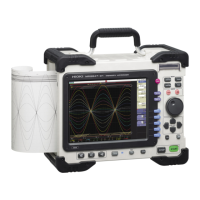Others
21
Probe compensation can be carried out by using 9665 10:1 Probe and 9666 100:1 Probe.
The instrument’s LCD provides SVGA (800 × 600) resolution. The wave-
form display area consists of 625 horizontal dots and 500 vertical dots.
The waveform display area is divided into 25 divisions horizontally, and
20 divisions vertically, with each division composed of 25 dots horizontally
and vertically.
Each data frame (one division) represents 100 samples horizontally, and
80 to 1600 data bits vertically. (depending on the input module)
Each displayed data frame (one division) changes in accordance with
expansion and compression of the time and voltage axes.
For the Memory Function (Sampling point recording):
The sampling period is 1/100
th
of the timebase. When the timebase is set to 100 ms/
div, the sampling period is 1 ms. Changing the timebase setting also changes the sam-
pling period accordingly.
For the Recorder Function (Envelope recording):
One data point is recorded every 1/100
th
of the timebase as two amplitude values: the
maximum and minimum values measured during the specified sampling period.
With the 10 ms/div timebase, one data point is recorded every
100 ms. When the
sampling period is set to 1 ms, 100 samples are provided in order to record each data
point. The values recorded for each data point are maximum and minimum values
among these 100 samples.
Probe Compensation
Select
[Calibration].
3
Displays the
[Environment] sheet
A 1 kHz 5 V square wave is outputted from an external output
terminal (NG/EXT.OUT2 Terminal). Probe compensation can be
carried out by using this signal.
Move the cursor to the
[NG/EXT OUT2] item.
Others
About the Screen
Timebase and Sampling
25div
20div
1 div = 100 samples
Maximum
Minimum
1div
1 2.... ....100
Sampling Period
Sampling Points

